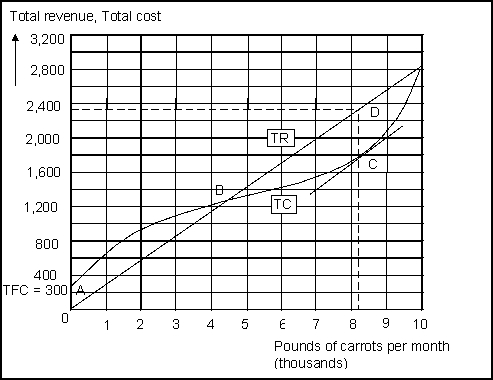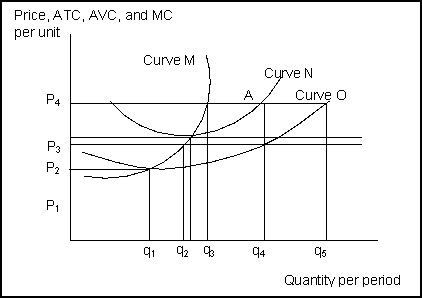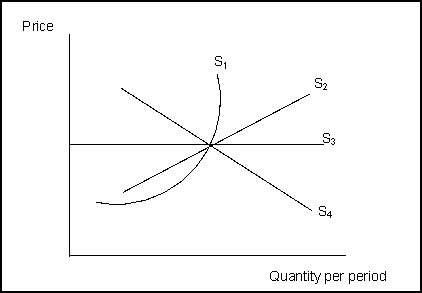A) Economists believe that they can understand most markets by applying the model of demand and supply.
B) When economists apply the model of demand and supply, they are using the model of perfect competition.
C) Many changes in the past 20 years have made markets more competitive by increasing ease of entry.
D) Price-taking firms produce differentiated goods.
F) None of the above
Correct Answer

verified
Correct Answer
verified
True/False
Economic profit cannot exist under perfect competition.
B) False
Correct Answer

verified
Correct Answer
verified
Multiple Choice
The slope of the total revenue curve is:
A) net revenue.
B) marginal profit.
C) net profit.
D) marginal revenue.
F) B) and D)
Correct Answer

verified
Correct Answer
verified
Multiple Choice
A decrease in production costs for firms in a perfectly competitive market will cause a(n) :
A) permanent increase in price.
B) economic loss for firms.
C) decrease in demand.
D) rightward shift in the market supply curve in the long run.
F) A) and D)
Correct Answer

verified
Correct Answer
verified
Multiple Choice
Use the following to answer questions  -(Exhibit: Total Revenue, Total Costs, and Economic Profit) Which of the following is (are) true?
-(Exhibit: Total Revenue, Total Costs, and Economic Profit) Which of the following is (are) true?
A) Total revenue and total cost are equal at approximately 8,300 pounds of output.
B) Marginal cost and marginal revenue are equal at approximately 8,300 pounds of output.
C) At approximately 4,500 pounds of output, marginal cost is zero and increasing returns sets in.
D) All of the above are true.
F) All of the above
Correct Answer

verified
Correct Answer
verified
Multiple Choice
A perfectly competitive firm is a:
A) price taker.
B) price searcher.
C) cost maximizer.
D) quantity taker.
F) A) and B)
Correct Answer

verified
Correct Answer
verified
Multiple Choice
In the short run, if AVC < P < ATC, a perfectly competitive firm:
A) produces output and earns an economic profit.
B) produces output and incurs an economic loss.
C) does not produce output and earns an economic profit.
D) does not produce output and earns zero economic profit.
F) A) and B)
Correct Answer

verified
Correct Answer
verified
Multiple Choice
Use the following to answer questions -(Exhibit: Total Cost for a Perfectly Competitive Firm) If the market price is $4.50, profit at the profit-maximizing quantity of output is:
A) $2.00.
B) $4.50.
C) $5.00.
D) $34.00.
F) A) and B)
Correct Answer

verified
Correct Answer
verified
True/False
At any level of output less than the most profitable one, an increase in output adds more to a firm's total cost than to its total revenue.
B) False
Correct Answer

verified
Correct Answer
verified
Multiple Choice
Use the following to answer questions  -(Exhibit: Profit Maximizing) The exhibit shows cost curves for a firm operating in a perfectly competitive market.Which of the following statements is true?
-(Exhibit: Profit Maximizing) The exhibit shows cost curves for a firm operating in a perfectly competitive market.Which of the following statements is true?
A) AFC is represented in this exhibit by the vertical distance between Curve M and Curve N at any level of output.
B) AFC is represented in this exhibit by the vertical distance between Curve N and Curve O at any level of output.
C) This exhibit illustrates the long run because all costs are variable.
D) Quantity q2 is to the left of the shutdown point.
F) A) and C)
Correct Answer

verified
Correct Answer
verified
Multiple Choice
The shutdown point is:
A) the point at which economic profit is zero.
B) the minimum level of AVC.
C) the intersection of the MC and ATC curves.
D) the minimum level of AFC.
F) B) and D)
Correct Answer

verified
Correct Answer
verified
True/False
In perfect competition, P = MR = MC because that is where firms maximize profits.
B) False
Correct Answer

verified
Correct Answer
verified
Multiple Choice
Accountants use only _______ costs in their computations of short-run total cost.
A) opportunity
B) implicit
C) explicit costs
D) variable
F) None of the above
Correct Answer

verified
Correct Answer
verified
True/False
A firm's total revenue curve in perfect competition is an upward-sloping straight line.
B) False
Correct Answer

verified
Correct Answer
verified
Multiple Choice
Suppose that automobile buyers in the southern part of a town have no idea what prices are being paid in the northern part of town.This situation violates the perfect competition assumption of:
A) many buyers and sellers.
B) identical goods.
C) complete information.
D) no discrimination.
F) A) and D)
Correct Answer

verified
Correct Answer
verified
Multiple Choice
Use the following to answer questions
 -(Exhibit: Supply: Short and Long Run) S3 would be the _______-run supply curve if _______.
-(Exhibit: Supply: Short and Long Run) S3 would be the _______-run supply curve if _______.
A) long; expanded production leaves production costs unchanged
B) short; expanded production changes production costs
C) long; there is no entry into or exit from the industry
D) medium; costs are changed if there is easy entry
F) C) and D)
Correct Answer

verified
Correct Answer
verified
True/False
In a perfectly competitive industry, a change in fixed cost will have no effect on price in the long run.
B) False
Correct Answer

verified
Correct Answer
verified
Multiple Choice
Use the following to answer questions  -(Exhibit: Profit Maximizing) The exhibit shows cost curves for a firm operating in a perfectly competitive market.If the market price is P4, the firm will produce _______ in the short run.
-(Exhibit: Profit Maximizing) The exhibit shows cost curves for a firm operating in a perfectly competitive market.If the market price is P4, the firm will produce _______ in the short run.
A) q2 and break even
B) q2 and make an economic profit
C) q3 and make an economic profit per unit equal to the vertical distance between P4 and Curve N at that quantity
D) q2 and make an economic profit per unit equal to the vertical distance between P4 and Curve O at that quantity
F) None of the above
Correct Answer

verified
Correct Answer
verified
Multiple Choice
Which of the following is true?
A) Profit per unit is price minus AVC.
B) Total economic profit is per unit profit times quantity.
C) If price is less than ATC, the firm will shut down in the short run.
D) If price is less than marginal cost, the perfectly competitive firm should raise the price and increase output.
F) B) and D)
Correct Answer

verified
Correct Answer
verified
Multiple Choice
Which of the following is true in a perfectly competitive market?
A) One unit of a good or service cannot be differentiated from any other on any basis.
B) Brand preferences exist but are very slight.
C) Barriers to entry are relatively strong.
D) Information is costly.
F) C) and D)
Correct Answer

verified
Correct Answer
verified
Showing 81 - 100 of 267
Related Exams